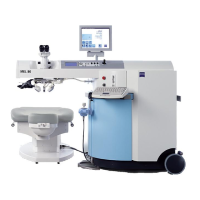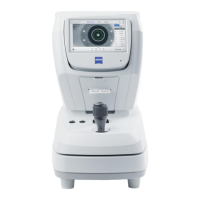Humphrey Field Analyzer II-
i
series User Manual 2660021145640 A
STATPAC Analysis & Printing
7-7
• The plot label (“24-2”, “30-2”) below the Progression Analysis plot on the SFA-GPA printout
will not be printed.
• The GPA symbol legend on the SFA-GPA printout will not be printed.
Global Indices
A short table of Global Indices appears on the far right
side of the page (shown as “D” in Figure 7.1).
Here STATPAC has made some calculations to provide over
all guidelines to help the practitioner
assess the field results as a whole rather than on the point-by-point basis shown in the Total
Deviation and Pattern Deviation plots. The global indices are calculated from deviations in the
age-corrected normals data. The “p” (probability) values for the global indices, discussed below, do
not need to be corrected again for age.
Visual Field Index (VFI): VFI is a measur
e of the patient’s overall visual function as compared to an
age-adjusted normal population. It is a weighted average of the ratio of the measured threshold to
the age-adjusted normal threshold for all points that have depressions in the Pattern Deviation at
the 5% level or higher.
A VFI of 100% means that the portion of the visual field that corresponds to the 24-2 test pattern
displays no points that are depressed relative to the age-adjusted normal hill of vision at the 5% level
or higher. As visual field loss progresses, the VFI value will fall. A VFI of 0% corresponds to a field
with no measured light sensitivity. Because it is based only on points that are significantly depressed
in Pattern Deviation, the VFI is relatively insensitive to visual field changes due to cataract.
The VFI is weighted to give increased importance to thresholds near the point of fixation, so that it
is a good indicator of changes in functional vision. The VFI for a visual field defect progressing
toward the central field will decrease more rapidly than the VFI for a defect that is progressing along
the periphery.
Mean Deviation (MD): MD is the ave
rage elevation or depression of the patient’s overall field
compared to the normal reference field. If the deviation is significantly outside the population
norms, a “p” value is given. For example, if p < 2%, this means that fewer than 2% of the normal
population shows an MD larger than that found in this test. Categories for p values are p < 10%,
p < 5%, p < 2%, p < 1%, and p < 0.5%.
A significant MD may indicate that the patient has an
overall depression, or that there is significant
loss in one part of the field and not in others. MD is best interpreted in relation to the Total and
Pattern Deviation plots.
Pattern Standard Deviation (PSD): PSD is
a measurement of the degree to which the shape of the
patient’s measured field departs from the normal, age-corrected reference field. A low PSD indicates
a smooth hill of vision. A high PSD indicates an irregular hill and may be due either to variability in
patient response or to actual field irregularities. The statistical significance for PSD is indicated using
the same categories for “p” as with the mean deviation.
Short term fluctuation (SF) and Corrected Pattern Standar
d Deviation (CPSD) are indices associated
with the now obsolete Full Threshold and FastPac thresholding programs. These indices are
discussed in Appendix (L) for older test strategies.

